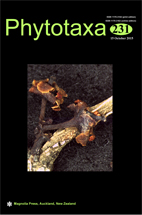Abstract
The genus Tropicoporus was recently introduced for accommodating species of the Inonotus linteus complex in Hymenochaetaceae. It is characterized by annual to perennial, resupinate, effused-reflexed to pileate basidiocarps with homogeneous to duplex context, a monomitic to dimitic hyphal system in context/subiculum and dimitic in trama, presence of hymenial setae, absence of hyphoid setae, and ellipsoid, broadly ellipsoid to subglobose, colored, slightly thick- to thick-walled basidiospores. Tropicoporus is similar to Sanghuangporus, which was another newly introduced genus for species of the Inonotus linteus complex, but the two genera are in two distinct clades in phylogeny. In addition, the latter accommodates perennial and pileate species only. In this study, two specimens recently collected from Chiang Mai, Thailand were described as Tropicoporus boehmeriae sp. nov. based on morphological and phylogenetic evidence. The new species is characterized by annual and exclusively resupinate basidiocarps and the smallest basidiospores (2.2–2.9 × 2–2.5 μm) within the Inonotus linteus complex. Tropicoporus boehmeriae mostly resembles T. tropicalis; however, T. tropicalis has larger basidiospores (3–4.5 × 2.5–4 μm) and was originally described from Brazil. The differences between Tropicoporus boehmeriae and other species possibly belonging to Tropicoporus, viz. Fulvifomes cesatii, F. glaucescens and F. minisporus, are discussed.

